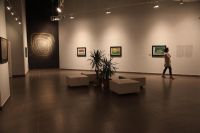|
Friedensreich Hundertwasser: Regentag
From 20 March 2014 to 15 June 2014
Cafesjian Center for the Arts Art must warn; that is its duty, but it must at the same time find a solution. Friedensreich Hundertwasser, 1982
His vision was a revolt; his art was the gateway to a more beautiful world in harmony with nature. Austrian artist, architect and visionary ecologist Friedensreich Hundertwasser (1928-2000) is undeniably one of the most vibrant and controversial characters of 20th century post-war art, whose creative activities were an open protest against the increasing threats of human society to the planet. He was born as Friedrich Stowasser in Vienna to a family of a Jewish mother and a Christian father, who died when the artist was one year old. Surviving the horrors of the Second World War, which cost the lost of almost all of his maternal family, he adopted a vision of life that rejected rationalism and all its totalitarian manifestations, the galloping post-industrial consumerism and mass production, the straight line as a “rotten foundation of our doomed civilization”. Hundertwasser envisioned a theory for a new world that would bring salvation to mankind and establish a new order of life, peace, and universal harmony. His philosophy of life was built on a ceaseless cycle of five interrelated layers for human existence; Epidermis- the biological skin, Clothes - the manmade skin, House - the protective skin, Identity - the social skin and the Environment - the planetary skin. The organic correlation of these layers could only lead to a reconciliation of mankind with the ecology of the planet. Hundertwasser believed that art was the bridge between man and nature, and the artist was in a unique position to prepare this peace treaty with nature. In contrast to his numerous civic protests and action-manifestations, he resurrected the “lost paradise” of mankind in his paintings and miraculous architectural creations. Rebelling against the development of modern art and the avant-garde as a “panopticon of horrors”, Hundertwasser developed his utopian vision of beauty and hope featured in his works with radiant colors and decorative biomorphic shapes. Whereas the roots of his visual language lay in Viennese tradition, Art Nouveau, Secession painters, and in the magic of the Orient, the main source of his formal aesthetics springs from nature and its forms. The spiral becomes the metaphor of the artist’s oeuvre and ideology as an expression of the biological beginning of life as opposed to the geometry of the straight line. The Regentag portfolio (Look at it on a Rainy Day) from the Gerard L. Cafesjian Collection is one of Hundertwasser’s major works composed of ten silkscreen prints. With their innovative and technically meticulous execution, the works on exhibit illustrate the artist’s distinctive style and pictographic language. The title of the portfolio, Regentag, also stands as a metaphor for the artist’s work and character: the word Regentag, which translates “rainy day”, is a part of his name and personality; it is also the name of the small ship which became an exodus for the lonely visionary to open horizons of paradise. Hundertwasser’s life and art are homage to nature, preaching the reconciliation of man with nature to regain freedom of individual creativity and identity. His utopian visions are crystallized in the artist’s kingdom of harmony and peace, reanimated in his works and through the spectator’s own internal perception. |






